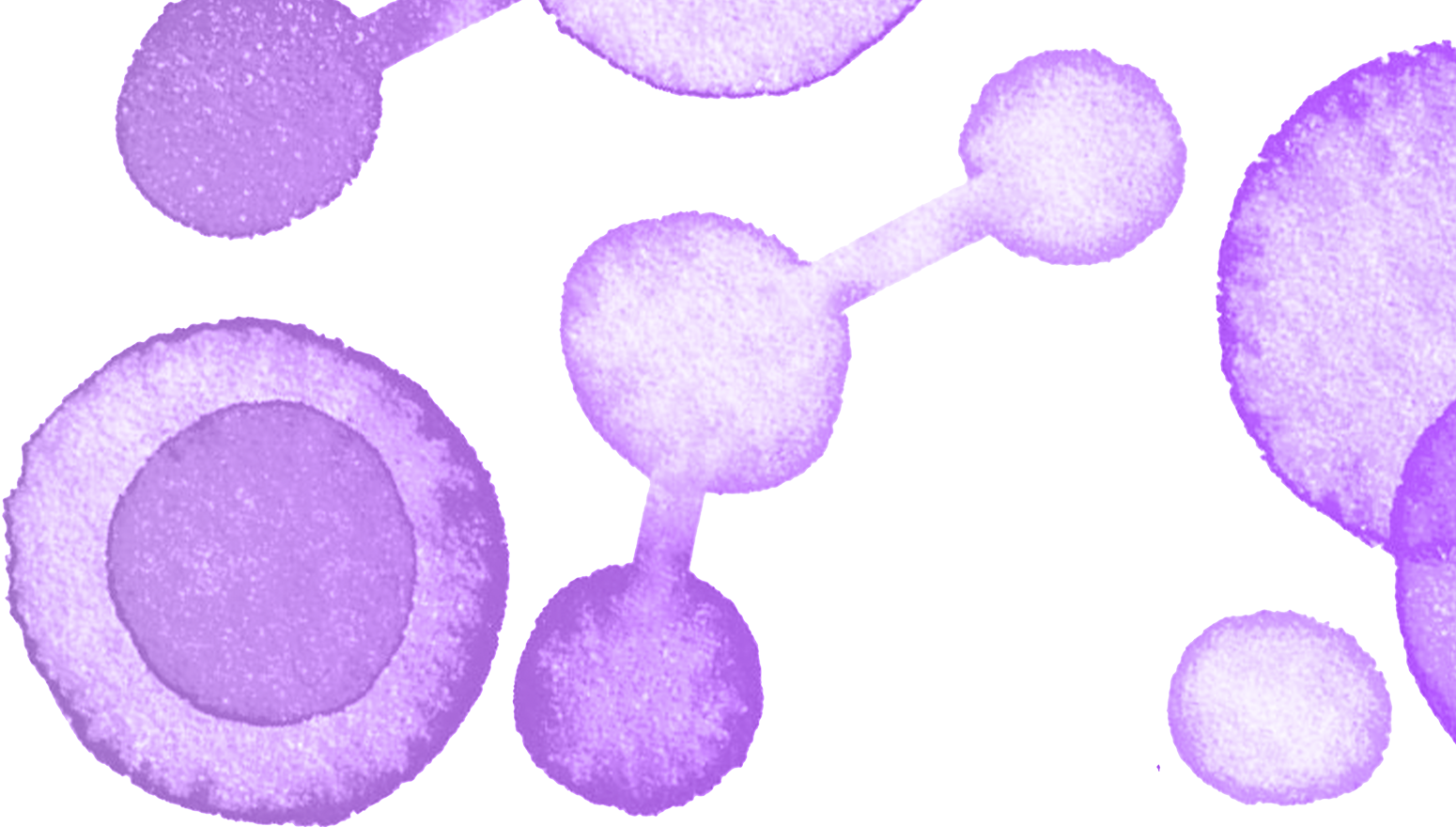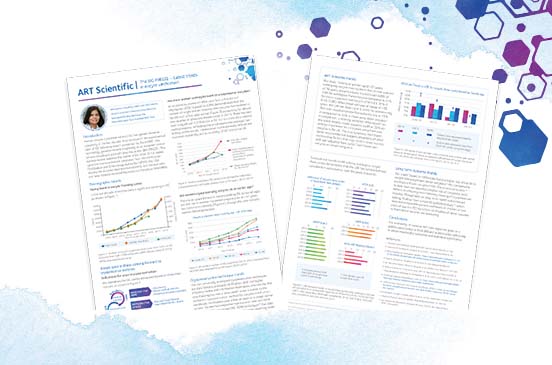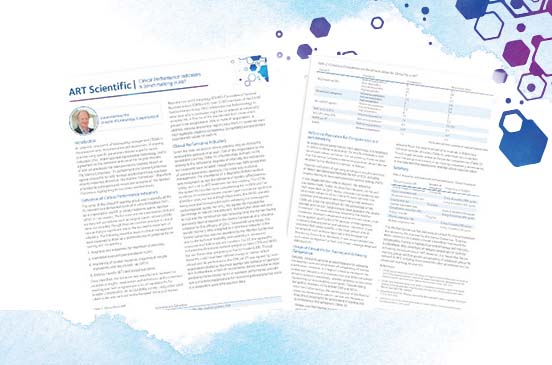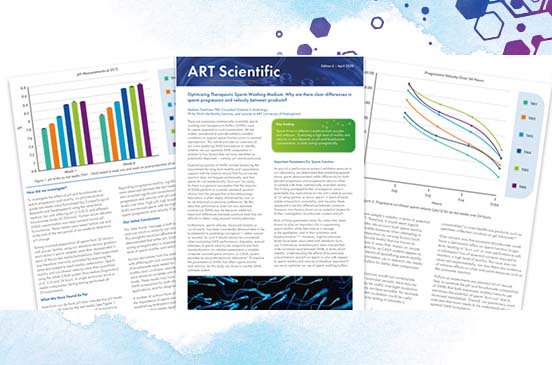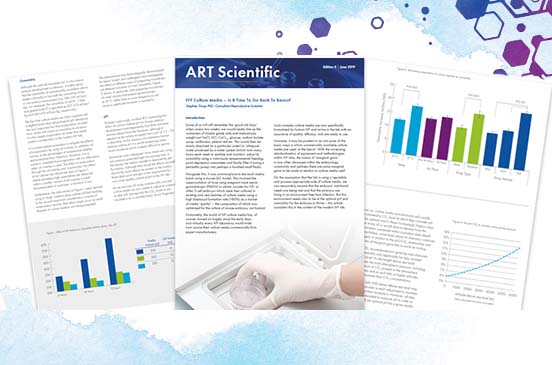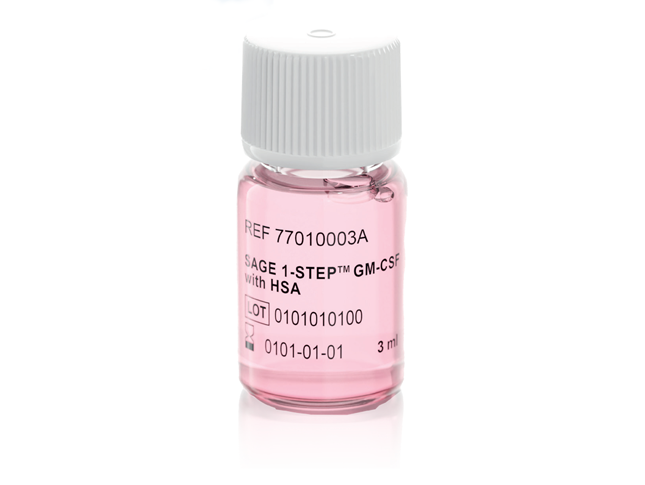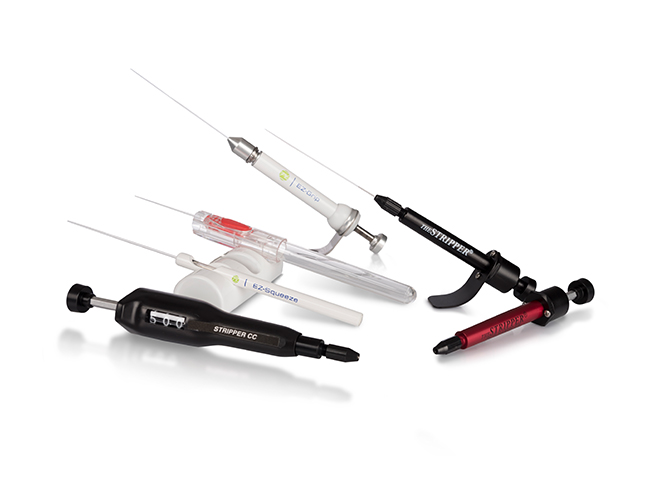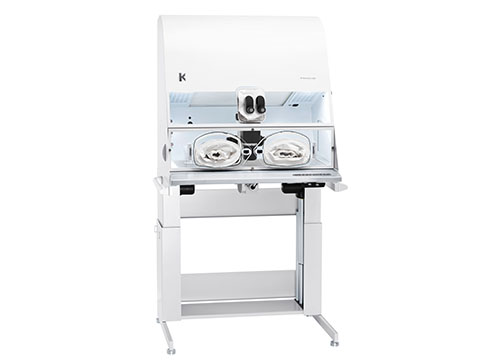Introduction
An ongoing challenge in ART culture media formulation is to provide the survival factors that support embryos through the stress of ex vivo culture. One survival factor that embryos expect to contact in the natural conception environment is the cytokine granulocyte-macrophage colony-stimulating factor (GM-CSF, also known as CSF2 ).
GM-CSF has been demonstrated in extensive pre-clinical and clinical research to promote development of healthy human embryos. After natural conception in vivo, GM-CSF is secreted into the fallopian tube and uterus and is present in the fluid bathing the developing embryo. Receptors for GM-CSF are expressed on the surface of the embryo from the zygote through to implanting blastocyst stage, and after implantation trophoblast cells also express GM-CSF receptors. In humans, clinical trials have demonstrated that GM-CSF promotes blastocyst development and increases the chance of implantation success, particularly in women where previous embryo loss has occurred.
Cytokines – physiological regulators of embryo development
Cytokines – physiological regulators of embryo development In a natural conception in vivo the embryo is exposed to a changing mixture of cytokines as it moves through the oviduct and uterus before implantation. Cytokines act as cell-cell signaling agents that mediate communication between the embryo and maternal tissues, regulating synchronous development and maximizing the chances of implantation success. Although embryos can develop in vitro in simple culture media, there is good evidence that better developmental potential is achieved when embryos are exposed to cytokines in the natural conception environment.1, 2
These cytokines fine-tune gene expression and protect embryos from cell stress, which in turn promotes cell survival and on-time development. The result is to increase implantation competence and development of a robust placenta.1, 3, 4
A wide range of embryo-derived cytokines promote preimplantation embryo development. Many of these cytokines stimulate overlapping signaling pathways. These so called ‘autocrine’ factors explain why IVF embryos grow better when cultured in groups and in small volumes of culture media.
Cytokines do not stimulate the mitotic cell cycle; rather they act as survival agents to prevent cells from constitutive death pathways mediated by p53-induced apoptosis.5 A certain degree of apoptosis is normal in embryos, in order to remove aneuploid or otherwise damaged cells.6 This is a necessary biological mechanism for elimination of abnormal or unwanted cells in development.7 There is no evidence that cytokines rescue abnormal cells, in embryos or indeed in other cell types.
Even with best practice and conditions to promote autocrine cytokine actions, embryos develop at a slower rate and with fewer cells in vitro than in vivo.2 This demonstrates the crucial role of paracrine factors normally secreted by maternal tissues. In vivo, cytokines released from oviductal and uterine cells communicate with the developing embryo as it traverses the reproductive tract prior to implantation. Maternal paracrine factors act in concert with autocrine mediators to modulate the endogenous developmental program (Figure 1).
Figure 1: Autocrine and paracrine action of cytokines in the reproductive tract.
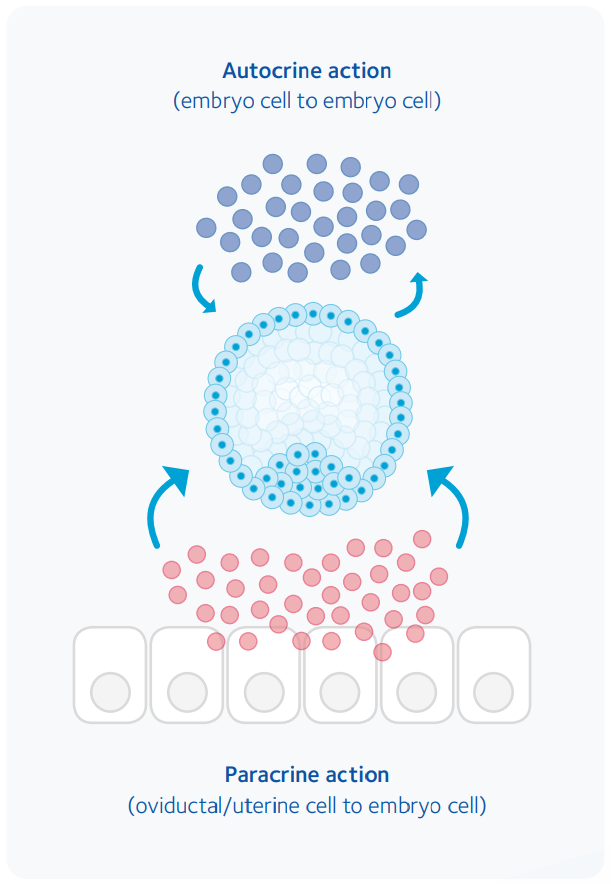
GM-CSF, a key cytokine regulator
One cytokine that is very low or absent in embryos is GM- CSF.8, 9 In women, GM-CSF is secreted by fallopian tubal and uterine epithelial cells in maximal amounts during the mid-luteal phase.10, 11 GM-CSF promotes survival in embryos by enhancing normal glucose uptake12 and suppressing stress response genes and apoptosis, which occur in the absence of cytokines.13 The GM-CSF response may interact with environmental stressors, since GM-CSF appears most effective in sustaining blastocysts when stress is induced by omitting human serum albumin from the culture medium.14 One role of albumin is to act as a carrier for autocrine cytokines that sustain embryo development, which is one reason why embryos grow better when sufficient albumin is present. Human serum albumin may carry GM-CSF into culture media preparations, explaining why ultrasensitive technology sometimes detects GM-CSF in embryo culture media at extremely low, femtomolar concentrations.15
In human IVF embryos, in vitro culture can lead to arrested, delayed and abnormal cell division often with fewer than 50% of embryos reaching the blastocyst stage. Strong embryotrophic effects of GM-CSF are seen in human embryos,16 with addition of GM-CSF substantially increasing the proportion of embryos developing to blastocysts.6, 16 The developmental competence of blastocysts, assessed by hatching, trophectoderm outgrowth and attachment to extracellular matrix-coated culture dishes, is markedly improved by GM-CSF exposure.16 GM-CSF has an important role, since when human IVF embryos were co-cultured with autologous endometrial cells, production of GM-CSF correlated with likelihood of successful pregnancy after embryo transfer.17 It seems likely that the pro-survival effects of GM-CSF operate from very early in embryo development – animal studies indicate beneficial effects even during oocyte development.18, 19
The cytokine environment provided by the female reproductive tract at conception can be a major factor in programming later fetal and placental development. Even small perturbations in blastomere number and inner cell mass / trophectoderm allocation in the blastocyst influence the growth trajectory of the fetus and offspring.20 Robust animal studies show that outcomes for embryos cultured with GM-CSF are improved in terms of offspring survival and health during their life-course.
There is no evidence that GM-CSF ‘rescues’ chromosomally abnormal blastomeres or embryos. A study using human IVF embryos prepared from donor oocytes confirmed that no increase in chromosomal abnormality was evident in embryos cultured with GM-CSF.21 Culture with GM-CSF resulted in 34.8% uniformly normal embryos, compared with 33.3% uniformly normal embryos in the absence of cytokine.
Clinical studies of GM-CSF in IVF embryo development
To evaluate the effect of addition of GM-CSF to human IVF embryos on implantation rate, a multicenter, randomized, placebo-controlled, double-blind prospective study involving 1,332 Danish and Swedish patients recruited from 14 fertility clinics commenced in 2007. Fertilization, embryo culture until day 3 and embryo transfer utilized either control medium, or medium supplemented with 2 ng/mL GM-CSF. GM-CSF gave a significant increase in implantation rate at gestational week 12, with an ongoing implantation rate (number of fetal heartbeats expressed as a ratio of embryos transferred) of 23.0% for the GM-CSF group, compared with 18.7% for the control group.22
This led to a higher likelihood of live birth, with no effect on stillbirth, perinatal death, or fetal abnormality, while gestational length and birth weight were unchanged.22
The most profound effect of GM-CSF was evident in women with previous miscarriage after IVF or natural conception, where the ongoing implantation rate at week 12 was increased by 40%, from 16.5% in control medium to 23.2% with GM-CSF. Follow-up on children born in the completed study shows that GM-CSF increased the live birth rate by 28% in the miscarriage subgroup, from 23.1% to 29.6%. These results underpinned CooperSurgical’s release of EmbryoGen™ and BlastGen™, first-in-class embryo culture media containing GM-CSF for cleavage stage and blastocyst development, respectively.
This large clinical trial provided compelling evidence of benefits of GM-CSF in IVF embryo culture media for successful pregnancy and a healthy infant at term. Some women may gain greater benefit when the reproductive tract is less capable of supporting embryo development, or embryos are more vulnerable to culture-induced stress.
Over the last 10 years, there have been several smaller studies to evaluate the utility of GM-CSF in the clinical IVF setting. Many of these indicate positive effects, including in older women and women with previously poor IVF outcomes,23-25 despite most being underpowered for firm conclusions. One small study reported no benefit.26 It is important that future studies include robust design and adequate control groups to enable a thorough meta-analysis,27 as this is the gold standard for evidence synthesis. Reassuringly, no studies show evidence of any adverse outcome when GM-CSF-containing media are used.
An important emerging application of GM-CSF is to support recovery of vitrified blastocysts after thawing. A good quality study in 430 Japanese women showed the ongoing pregnancy and live birth rates after GM-CSF use were 42.9% and 40.3%, compared to 31.1% and 30.5% in the control group.28
An exciting advance is the availability of GM-CSF in SAGE 1-Step™ culture medium. Many embryologists prefer single- step culture for its practical advantages and reduced stress on embryos. Pilot studies to evaluate outcomes using this medium are showing encouraging results.29
Summary
GM-CSF was the first cytokine developed for application in human IVF, based on solid scientific investigation of the natural biology of conception and early pregnancy. The evidence continues to build for the beneficial effects of including GM-CSF in embryo culture media, particularly in vulnerable patients and conditions wherein protection from culture-induced cell stress is desirable. Well-designed clinical trials are required to consolidate the evidence to substantiate use of GM-CSF in reproductive medicine and better understand the circumstances and patient groups in which it offers the greatest benefit.
Conflict of Interest Statement: Sarah Robertson PhD is an inventor on patents concerning utility of GM-CSF in IVF culture medium and receives royalty income from CooperSurgical.
References
1. Hardy K, Spanos S. Growth factor expression and function in the human and mouse preimplantation embryo. J Endocrinol 2002; 172:221-236.
2. Richter KS. The importance of growth factors for preimplantation embryo development and in-vitro Curr Opin Obstet Gynecol 2008; 20:292-304.
3. O’Neill C. The potential roles for embryotrophic ligands in preimplantation embryo development. Hum Reprod Update 2008; 14:275-288.
4. Bromfield JJ, Schjenken JE, Chin PY, Care AS, Jasper MJ, Robertson SA. Maternal tract factors contribute to paternal seminal fluid impact on metabolic phenotype in offspring. Proc Natl Acad Sci USA 2014; 111:2200-2205.
5. O’Neill C, Li Y, Jin XL. Survival signaling in the preimplantation embryo. Theriogenology 2012; 77:773-784.
6. Sjoblom C, Wikland M, Robertson SA. Granulocyte-macrophage colony-stimulating factor (GM-CSF) acts independently of the beta common subunit of the GM-CSF receptor to prevent inner cell mass apoptosis in human embryos. Biol Reprod 2002; 67:1817-1823.
7. Hardy K. Apoptosis in the human embryo. Rev Reprod 1999; 4:125-134.
8 Dominguez F, Meseguer M, Aparicio-Ruiz B, Piqueras P, Quinonero A, Simon C. New strategy for diagnosing embryo implantation potential by combining proteomics and time-lapse technologies. Fertil Steril 2015; 104:908-914.
9. Huang G, Zhou C, Wei CJ, Zhao S, Sun F, Zhou H, Xu W, Liu J, Yang C, Wu L, Ye G, Chen Z, Huang Y. Evaluation of in vitro fertilization outcomes using interleukin-8 in culture medium of human preimplantation embryos. Fertil Steril 2017; 107:649-656.
10. Giacomini G, Tabibzadeh SS, Satyaswaroop PG, Bonsi L, Vitale L, Bagnara GP, Strippoli P, Jasonni VM. Epithelial cells are the major source of biologically active granulocyte macrophage colony-stimulating factor in human endometrium. Human Reprod 1995; 10:3259-3263.
11. Zhao Y, Chegini N, Flanders KC. Human fallopian tube expresses transforming growth factor (TGF beta) isoforms, TGF beta type I-III receptor messenger ribonucleic acid and protein, and contains [125I]TGF beta-binding sites. J Clin Endocrinol Metab 1994; 79:1177-1184.
12. Robertson SA, Sjoblom C, Jasper MJ, Norman RJ, Seamark RF. Granulocyte[1]macrophage colony-stimulating factor promotes glucose transport and blastomere viability in murine preimplantation embryos. Biol Reprod 2001; 64:1206-1215.
13. Chin PY, Macpherson AM, Thompson JG, Lane M, Robertson SA. Stress response genes are suppressed in mouse preimplantation embryos by granulocyte-macrophage colony-stimulating factor (GM-CSF). Hum Reprod 2009; 24:2997-3009.
14. Karagenc L, Lane M, Gardner DK. Granulocyte-macrophage colony-stimulating factor stimulates mouse blastocyst inner cell mass development only when media lack human serum albumin. Reprod Biomed Online 2005; 10:511-518.
15. Chen P, Huang C, Sun Q, Zhong H, Xiong F, Liu S, Yao Z, Liu Z, Wan C, Zeng Y, Diao L. Granulocyte-Macrophage Colony Stimulating Factor in Single Blastocyst Conditioned Medium as a Biomarker for Predicting Implantation Outcome of Embryo. Front Immunol 2021; 12:679839.
16. Sjoblom C, Wikland M, Robertson SA. Granulocyte-macrophage colony-stimulating factor promotes human blastocyst development in vitro. Hum Reprod 1999; 14:3069-3076.
17. Spandorfer SD, Barmat LI, Liu HC, Mele C, Veeck L, Rosenwaks Z. Granulocyte macrophage-colony stimulating factor production by autologous endometrial co[1]culture is associated with outcome for in vitro fertilization patients with a history of multiple implantation failures. Am J Reprod Immunol 1998; 40:377-381.
18. Gilchrist RB, Rowe DB, Ritter LJ, Robertson SA, Norman RJ, Armstrong DT. Effect of granulocyte-macrophage colony-stimulating factor deficiency on ovarian follicular cell function. J Reprod Fertil 2000; 120:283-292.
19. Peralta OA, Bucher D, Fernandez A, Berland M, Strobel P, Ramirez A, Ratto MH, Concha I. Granulocyte-macrophage colony stimulating factor (GM-CSF) enhances cumulus cell expansion in bovine oocytes. Reprod Biol Endocrinol 2013; 11:55.
20. Thompson JG, Kind KL, Roberts CT, Robertson SA, Robinson JS. Epigenetic risks related to assisted reproductive technologies: short- and long-term consequences for the health of children conceived through assisted reproduction technology: more reason for caution? Hum Reprod 2002; 17:2783-2786.
21. Agerholm I, Loft A, Hald F, Lemmen JG, Munding B, Sorensen PD, Ziebe S. Culture of human oocytes with granulocyte-macrophage colony-stimulating factor has no effect on embryonic chromosomal constitution. Reprod Biomed Online 2010; 20:477-484.
22. Ziebe S, Loft A, Povlsen BB, Erb K, Agerholm I, Aasted M, Gabrielsen A, Hnida C, Zobel DP, Munding B, Bendz SH, Robertson SA. A randomized clinical trial to evaluate the effect of granulocyte-macrophage colony-stimulating factor (GM-CSF) in embryo culture medium for in vitro fertilization. Fertil Steril 2013; 99:1600-1609.
23. Chu D, Fu L, Zhou W, Li Y. Relationship between granulocyte-macrophage colony[1]stimulating factor, embryo quality, and pregnancy outcomes in women of different ages in fresh transfer cycles: a retrospective study. J Obstet Gynaecol 2020; 40:626-632.
24. Zhou W, Chu D, Sha W, Fu L, Li Y. Effects of granulocyte-macrophage colony[1]stimulating factor supplementation in culture medium on embryo quality and pregnancy outcome of women aged over 35 years. J Assist Reprod Genet 2016; 33:39-47.
25. Tevkin S, Lokshin V, Shishimorova M, Polumiskov V. The frequency of clinical pregnancy and implantation rate after cultivation of embryos in a medium with granulocyte macrophage colony-stimulating factor (GM-CSF) in patients with preceding failed attempts of ART. Gynecol Endocrinol 2014; 30 Suppl 1:9-12.
26. Rose RD, Barry MF, Dunstan EV, Yuen SM, Cameron LP, Knight EJ, Norman RJ, Hull ML. The BlastGen study: a randomized controlled trial of blastocyst media supplemented with granulocyte-macrophage colony-stimulating factor. Reprod Biomed Online 2020; 40:645-652.
27. Armstrong S, MacKenzie J, Woodward B, Pacey A, Farquhar C. GM-CSF (granulocyte macrophage colony-stimulating factor) supplementation in culture media for women undergoing assisted reproduction. Cochrane Database Syst Rev 2020; 7:CD013497.
28. Okabe-Kinoshita M, Kobayashi T, Shioya M, Sugiura T, Fujita M, Takahashi K. Granulocyte-macrophage colony-stimulating factor-containing medium treatment after thawing improves blastocyst-transfer outcomes in the frozen- thawed blastocyst-transfer cycle. J Assist Reprod Genet 2022; 39:1373-1381.
29. Adanacioglu F, Cetin C, Tokat G, Adanacioglu D, Karasu AFG, Cetin MT. Comparison of the Effects of GMCSF-Containing and Traditional Culture Media on Embryo Development and Pregnancy Success Rates. Rev Bras Ginecol Obstet 2022; 44:1047-1051.
